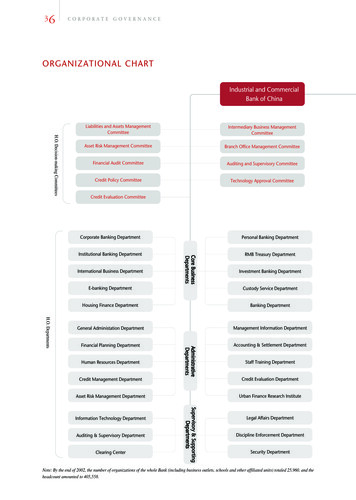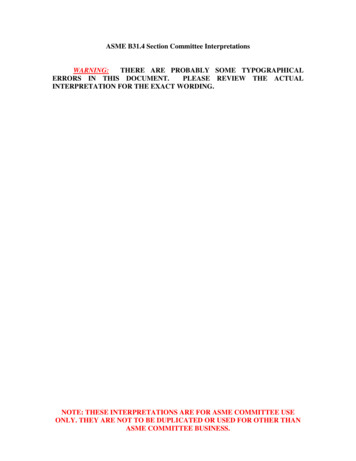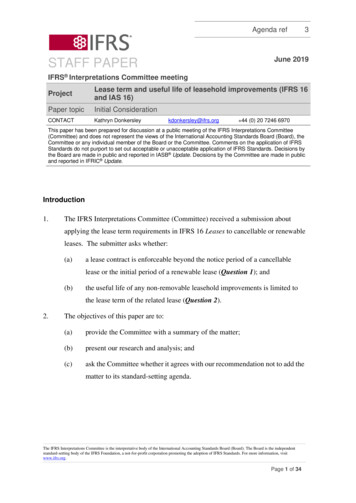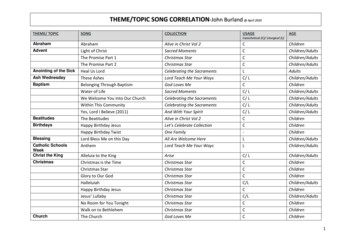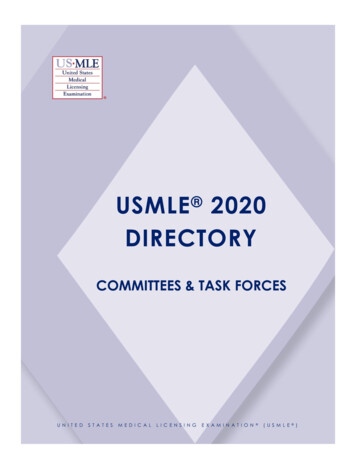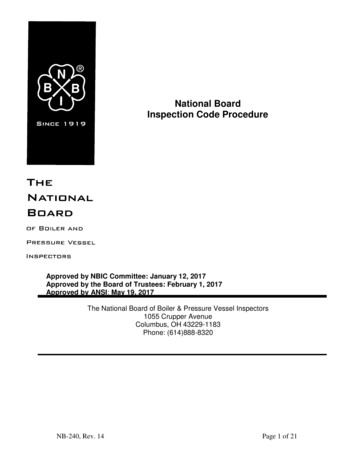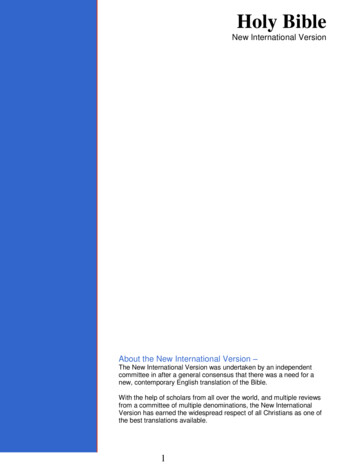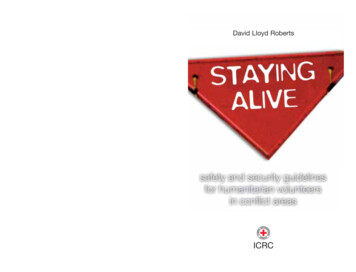
Transcription
Staying-Alive-cover.qxp13.1.20068:52Page 1ICRCDavid Lloyd Roberts0717/002 12.2005 4,000STAYING ALIVESTAYING ALIVE offers expert advice onsecurity to humanitarian volunteers operatingin conflict zones.Author David Lloyd Roberts has witnessedconflict from the viewpoint of both a militaryofficer and a humanitarian worker. His bookdraws on a unique variety of up-to-dateexperience.By explaining the different threats to yoursafety, this book lays to rest some of themystique surrounding the subject of fieldsecurity.Yes, there are dangers, but with some basicunderstanding of them they can be avoided orat least substantially reduced. As the oldsaying goes, “Knowledge dispels fear.”You are ultimately the guardian of your ownsafety and security. The knowledge providedby this book puts you in a better position todraw that critical line between the calculatedand the unacceptable risk, a line that you, andthose in your charge, must never cross.David Lloyd Roberts
David Lloyd RobertsSTAYING ALIVESafety and security guidelinesfor humanitarian volunteersin conflict areasInternational Committee of the Red Cross19 Avenue de la Paix1202 Geneva, SwitzerlandT 41 22 734 6001 F 41 22 733 2057E-mail: icrc.gva@icrc.orgwww.icrc.org
Q ICRC,1999Revised and updated edition, 2005
DEDICATIONTo my wife Charlie.
NOTICE: This book contains a series of guidelines for the safety and security ofstaff in the field. It does not cover all situations and the advice given is of a generalnature. The International Committee of the Red Cross therefore declines allresponsibility for cases in which the book’s recommendations do not provide thebest course of action.
CONTENTSACKNOWLEDGEMENTS .ABOUT THE AUTHOR .FOREWORD.INTRODUCTION .11131517Chapter 1: PERSONAL SECURITY .ADJUSTING .BE INQUISITIVE .USE YOUR COMMON SENSE AND JUDGEMENT .TAKE CARE OF YOURSELF .GROUP SAFETY AND SECURITY .THE AIM .19192020202121Chapter 2: THE NATURE OF MODERN CONFLICTAND THE BROAD RANGE OF CONFLICTSITUATIONS THAT YOU MIGHT FACE .INTERNATIONAL ARMED CONFLICT .NON-INTERNATIONAL ARMED CONFLICT .INTERNAL DISTURBANCES AND TENSIONS .ADDITIONAL FEATURES OF MODERN-DAY CONFLICT .DIRECT TARGETING OF HUMANITARIANS .THE BLURRING OF ROLES BETWEEN HUMANITARIANSAND THE MILITARY .THE ‘‘HEARTS AND MINDS’’ ISSUE .INTEGRATED OPERATIONS .BANDITRY AND CRIME .CHILD SOLDIERS .3031323334Chapter 3: PROTECTION AFFORDEDBY INTERNATIONAL HUMANITARIAN LAW .KNOWING THE LAW .HUMANITARIAN AID .MINES AND EXPLOSIVE REMNANTS OF WAR .SAFETY ZONES .35353738402323242527295
Chapter 4: THE MAJOR THREATSTO YOUR SAFETY AND SECURITY .THE MINE THREAT .Anti-personnel mines .Anti-tank mines .Dealing with the mine threat .Dealing with anti-personnel mines .The most dangerous areasin terms of anti-personnel mines .Dealing with anti-tank mines .THE THREAT FROM ARTILLERY, ROCKETS AND MORTAR FIRE .Artillery .Mortars .How these weapons are used .Dealing with the artillery and mortar threat .THE THREAT FROM SNIPER AND RIFLE FIRE .What is a sniper? .What can a sniper achieve? .What equipment does a sniper use? .Dealing with the sniper threat .Warning shots .THE AMBUSH THREAT .Dealing with the ambush threat .Reacting to an ambush .Encountering a recent ambush .THE THREAT FROM IMPROVISED EXPLOSIVE DEVICES .Dealing with the threat from improvisedexplosive devices .Avoiding or minimizing the danger of improvisedexplosive devices .THE GRENADE THREAT .Avoiding grenades .THE THREAT FROM BOOBY TRAPS .Avoiding booby traps 646566676868
THE THREAT FROM UNEXPLODED MILITARY ORDNANCE (UXO) .Unexploded cluster bombs .Avoiding unexploded military ordnance .THE THREAT FROM DEPLETED URANIUM MUNITIONS .Avoiding depleted uranium munitions .THE THREAT FROM THE AIR .Dealing with the threat from the air .68707071717272Chapter 5: THE THREAT FROM CHEMICAL,BIOLOGICAL, RADIOLOGICALAND NUCLEAR HAZARDS .A BIT OF PERSPECTIVE .TYPES OF CBRN THREAT .Chemical warfare agents .Toxic industrial chemicals .Biological warfare agents .Radiological and nuclear incidents .PROTECTING AGAINST THE CBRN THREAT .Assessing the threat .Detection .Medical countermeasures .Immediate action drills .Communal protective measures .Personal protective equipment .Decontamination .777777777878787979798181828384Chapter 6: ADDITIONAL AIDSTO YOUR SAFETY AND SECURITY .HOW ARE WE VIEWED BY THE ARMED FORCES AND SECURITYFORCES, LOCAL FACTIONS AND THE LOCAL POPULATION?HOW DO THEY BEHAVE TOWARDS US? .The view of the professional soldier .Complications facing the soldier in the conflict zone .Notable exceptions .Private security companies .Military protection .878788899192937
Promoting your organization .Weapons in your vehicle .Warnings or obstruction? .The civilian outlook .CHECK-POINTS/ROAD-BLOCKS .PLANNING, BRIEFING AND DEBRIEFING .How to plan .Briefing .Debriefing .SECURITY-INCIDENT REPORTS AND STATISTICS .Problems demanding attention .INCIDENT REPORTING .The immediate report .Follow-up reports .Chapter 7: PASSIVE-PROTECTION IDEASFOR YOUR SAFETY AND SECURITY .PROTECTING YOURSELF AND YOUR BUILDINGS .Materials and tools .Basic sandbag construction .BLAST WALLS, SHELTERS AND OTHER IDEAS .Blast walls .Shelters .Other ideas for passive protection .BUILDING SELECTION .PERSONAL PASSIVE-PROTECTION EQUIPMENT .The flak jacket .The ballistic jacket .The helmet .Armoured vehicles .Other forms of vehicle protection .VEHICLES AND DRIVING .Four-wheel drive .Driving 2114115116118121122123124125125126127128130
PERSONAL EFFECTS . 131A word on cameras . 133Chapter 8: MANAGEMENT ASPECTSOF SAFETY AND SECURITY .THE ROLE OF HEAD OF OFFICE/DELEGATION .Basic considerations .Stress management .CONTINGENCY/EVACUATION PLANS .Planning for a prolonged stay .Planning for evacuation .Partial evacuation .Full evacuation .FIRE PRECAUTIONS .135135135137138140141142143143Chapter 9: SPECIAL SITUATIONS .A STATE OF SIEGE .Enduring a state of siege .HOSTAGE SURVIVAL .Abduction .Post-capture .Health .The relationship with captors .Negotiation .Release .Hostage survival check-list .147147148149150150151151152152152Chapter 10: FIRST AID .THREATS .INJURY PATTERNS .SYSTEMATIC APPROACH .TREATMENT .Airway, breathing and circulation .Broken bones and burns .Cardio-pulmonary resuscitation .EQUIPMENT .1551551561561571571581591599
Chapter 11: HEALTH ON MISSION .IMMUNIZATION .KITS, SUPPLIES AND EQUIPMENT .TREATING INFECTIONS, PARASITES AND BITES .Malaria .Dengue fever .Viral haemorrhagic fevers .Pneumonia and respiratory infections .Skin and wound infections .Bites from dogs and other animals .Acute diarrhoea .Fevers .CLIMATIC EXTREMES .Too high .Too cold .Too hot .AVOIDING ACCIDENTS .Road accidents .Swimming .Home and work .Useful websites 68168169169170Chapter 12: TELECOMMUNICATIONS .VHF RADIO .The key to VHF .Radio antennas .Dead spots .HF RADIO .SATELLITE COMMUNICATIONS SYSTEMS .MOBILE PHONES .THE INTERNET AND COMPUTERS .THE PHONETIC ALPHABET .17117217217317417617717817918010
ACKNOWLEDGEMENTSThe author wishes to acknowledge and thank the followingpersons, whose support and encouragement helped greatly inproducing this book.The International Committee of the Red Cross, for sponsoringthe book.Philippe Dind, now retired from the ICRC, whose encouragement led to the first edition, and Patrick Brugger, the presentsecurity delegate, whose idea this second edition was.Ceri Hammond, senior editor at the ICRC’s CommunicationDepartment, and his staff, for their work in coordinating, editingand publication.Paul Wehrli, the ICRC’s information-systems operationscoordinator, for his contribution to the telecommunicationschapter.Colonel Timothy J. Hodgetts (QHP, OStJ, MBBS, MMEd, FRCP,FRCSEd, FFAEM, FIMCRCSEd, FRGS, L/RAMC), a servingdoctor in the British Army, for writing the chapter on first aid.Dr Ted Lankester (MA, MB, B Chir, MRCGP Ct), director ofhealth care at InterHealth, for writing the chapter concerninghealth on mission. Dr Lankester is also the author of ‘‘TheTraveller’s Good Health Guide’’ and ‘‘Travel Health in YourPocket’’, and with his colleagues acts as travel health adviser tothe British Red Cross and international NGOs.Major Ken Roberts, a serving environmental health officer in theBritish Army with experience in both CBRN issues andhumanitarian/disaster relief, and Ms Anthea Sanyasi,1 healthemergency planning officer for the UK Health ProtectionAgency, for cooperating in the writing of the chapter onchemical, biological, radiological and nuclear hazards.Eric ‘‘Buche’’ Buschacher, whose cartoons and graphics are asgreatly appreciated now as they were in the first edition.1Author of Extreme emergencies: Humanitarian assistance to civilian populationsfollowing chemical, biological, nuclear and explosive incidents --- A Sourcebook,ITDG Publishing, 2004.11
ABOUT THE AUTHORDavid Lloyd Roberts (MBE, LLM) is a graduate of the Royal MilitaryAcademy, Sandhurst. He was commissioned into the ParachuteRegiment of the British Army in 1966. His army career took him tovarious conflict zones. He was decorated for gallantry by his Queenin 1972 and was mentioned in dispatches for distinguished servicein 1978. He attended the Army Staff College at Queenscliff,Australia, in 1977. He holds a master of laws degree in internationalhuman rights law from Essex University in the UK. He is a fellow ofthe University of Essex Human Rights Centre. He is a Freeman ofthe City of London.On leaving the Army in 1993, he joined the ICRC as itsoperational security adviser and two years later moved to the unitresponsible for promoting international humanitarian law amongthe armed forces. He has carried out ICRC missions to Abkhazia,Afghanistan, Angola, Armenia, Azerbaijan, Bangladesh, Burundi,Cambodia, China, East Timor, Eritrea, Ethiopia, the formerYugoslavia, Fiji, Georgia, India, Israel and the occupied andautonomous territories, Mongolia, Nepal, North Korea, Pakistan,Papua New Guinea, the Philippines, Rwanda, Somalia, Sri Lanka,Taiwan and Zaire.Mr Roberts has witnessed armed conflict from both the military andhumanitarian perspective. This book draws on his unique experience to offer guidelines to humanitarian volunteers so that theymight carry out their important work more safely and securely.Following on from the success of the first edition of ‘‘StayingAlive’’, published in 1999, this revised and updated versionencompasses new and developing threats such as the one posedby chemical, biological, radiological and nuclear hazards, as well asnew chapters on first aid, staying healthy on mission and theprotection afforded to humanitarian volunteers by international law.His other publications include a handbook on the law of war for theIndian armed forces (1996), an article on training armed forces inthe law of war (International Review of the Red Cross, No. 319,July-August 1997) and ‘‘The Law of Armed Conflict’’, a 12-chaptertraining manual for armed and security forces, published by theICRC in 2002.13
Mr Roberts retired from the ICRC in 2003 and is now a consultantand lecturer in international humanitarian law, human rights law andsecurity issues in humanitarian endeavour.14
FOREWORDSecurity is an important concern for those engaged in humanitarianaction. The International Committee of the Red Cross (ICRC) isanxious to give to its staff all possible training and guidance in thisfield. That is the purpose of this book by David Lloyd Roberts.Mr Roberts joined the ICRC in 1993 on a three-month contract.When he recently retired from full-time duties, the three months hadgrown to 11 years. Mr Roberts advised the ICRC on practicalsecurity and safety measures for present-day conflicts. Over theyears his extensive military experience and thorough knowledge ofthe organization’s working methods have enabled the ICRC tomake considerable progress in this field. He was also involved inpromoting knowledge of the law of armed conflict among armedforces personnel, as well as remaining ‘‘on call’’ for securitymissions.In 1999 it was suggested that he should write a book specificallyaimed at humanitarian staff working in conflict areas. The bookwould deal with the dangers and lay down safety guidelines. Moregeneral matters such as threat assessment, security concepts anda number of security-management aspects were deliberately notincluded so as not to overburden an already dense text. In addition,the author confined himself to areas in which the ICRC could makea valuable contribution because of its unique status.The resulting book, ‘‘Staying Alive’’, has been a great success anddemand for it has prompted the ICRC to ask Mr Roberts to write arevised and updated edition. The result is here before you. It retainsall the successful elements of the first edition, most importantly itsuser-friendly presentation of practical advice. Its wealth ofinformation is intended as much for the staff of other humanitarianorganizations as for ICRC personnel. A greater awareness ofsecurity-related issues will in some cases help avert incidents andin most cases lessen their consequences.The new edition reflects the ever-changing conflict environment inwhich humanitarians have to work. It deals with new threats such asnuclear, chemical and biological weapons, and encompasses widerissues not covered in the first edition such as protection ofhumanitarian volunteers under international law and practical life15
saving first aid. The telecommunications chapter includes advice onthe use of modern equipment such as mobile phones.I am grateful to David Lloyd Roberts and all those other contributorswho have generously given of their time in the production of thisbook. I hope it will play an important part in enhancing the safety ofICRC delegates and other humanitarian staff.Jakob KellenbergerICRC President16
INTRODUCTIONAt the outset it is perhaps important to focus on the title and aim ofthis book. It is not being written for any specific non-governmentalorganization (NGO) or humanitarian organization. Every organization has its own particular rules and regulations and the reader willnaturally be expected to implement them. The aim of this book is tohighlight the common features of safety and security that apply orcould apply to us when working in conflict areas. It will attempt toexplain in layman’s terms the dangers we might face and some ofthe likely threats to our work.Through explanation we can hopefully lay to rest some of themystique surrounding the subject. Yes, there are dangers, but ifyou have a basic understanding of them, they can be avoided, orcertainly dramatically reduced. As the old saying goes, “Knowledge dispels fear.” Since you are ultimately the guardian of yourown safety and security, knowledge also puts you in a betterposition to define that important line which it is perhaps toodangerous for you, and those in your charge, to cross.Humanitarian workers ---- especially new volunteers ---- are bombarded (even before they reach the conflict zone!) with a plethora ofgood advice, rules, regulations and check-lists. My aim is certainlynot to burden you further. On the contrary, it is to combine the mainfeatures of these rules in one simple and useful book.Before going on, I should like to make a few points about termsused in the title.GUIDELINESThis is important. These are not rules. Rules will no doubt be issuedby your own organization. For example, “No driving at night in suchand-such a place,” or “Because of the curfew, be in your house bysuch-and-such a time.” These are quite clear and should beobeyed.Guidelines, on the other hand, are just that: the best availableadvice in a general setting or situation. They should be viewed assuch and not as the definitive answer to every problem. Forexample, one might suggest that if caught in the open with artillery17
shells falling very close to you, the best guideline would be to getout of your vehicle and take cover. However, if 20 metres in front ofyou there is a tunnel through a mountain, you would be very wise toput your foot down and seek its protection! Therefore, pleasecombine the contents of this book with your own common senseand judgement.There are times in this book when guidelines might become obviousrules, e.g. “Do not touch a mine.” In such cases the “Do not” willbe clearly highlighted.VOLUNTEERSRemember, you have volunteered for this work.In conflict there is inherent danger. You owe it to yourself to knowwhat those dangers are and how to minimize them.CONFLICT AREASThe book deals only with conflict areas. The subjects covered aretherefore fairly specific and do not encompass the other wideranging areas of humanitarian work such as disaster relief. It isnevertheless well to remember that relative calm and tranquillity inour modern world can quickly disintegrate into violence. Also, someof the topics are relevant in whatever theatre you find yourself:basic security measures against crime, use of the radio, fireprecautions, etc.We hope this book will be of some assistance to you in your vitalwork of assisting the victims of armed conflict.LOCALLY RECRUITED STAFFThis book is intended as much for the locally recruited staff ofhumanitarian organizations as it is for their expatriate staff.It is now generally agreed that good security for the individual andthe organization depends on the following interrelated factors:. how we are perceived and thus whether we are accepted bythe local people;. our behaviour as individuals;. our ability to listen, as opposed to preaching, and our ability toput our message across and project a professional image.18
CHAPTER 1PERSONAL SECURITYAs mentioned, you have volunteered to work in a conflict zone.Being sensible, you have given this matter some thought. You havenot approached it lightly. Conflict is dangerous; it is not a game. AllNGOs mention in their staff contracts at some point that theemployee accepts the risks inherent in his or her work. Most willthen ensure through good initial training, briefing and in-countryprocedures that you are fully prepared and looked after in the bestpossible way.Given good training and back-up, what can you do to help yourself?ADJUSTINGYour normal routine and behaviour will have to be adjusted to dealwith your new situation. Fine words. but what do they mean?Let’s be honest with ourselves and then make the necessaryadjustment. Imagine that you are walking down the main street ofyour home town on a wonderfully sunny Saturday morning. Youhave the whole weekend to look forward to. Your mind is in neutral,you are relaxing ---- and why not? Or you are driving home from theoffice. The car radio is playing some pleasant music and you arethinking of your busy day. On routine occasions like this you mightnot actually be fully aware of exactly where you are; you are justwandering around or driving bumper to bumper as you do everyday.In your new situation, in addition to the fact that free weekends arerare, you cannot simply behave as you are used to doing.In your new town or in the field, you must always be aware of exactlywhat is happening around you. You must be alert. You must try tothink ahead, to avoid problems and possible danger. Always knowwhere you are and where you are going. Getting lost could put youin danger. Take an interest in the immediate surroundings of thearea through which you are travelling; think about where you mighttake shelter or find cover if you need it. This represents quite a big19
change from your normal behaviour and lifestyle. If you make aconscious effort, it is surprising how quickly you will adjust and, as aresult, be much safer in your new environment.BE INQUISITIVESeek information about your new environment. Ask about the risksor threats to your security.In the turmoil of the operation under way, the newcomer issometimes not well briefed. Don’t be afraid or embarrassed to askquestions. Ask your boss, your colleagues, the local staff, localpeople and even the armed forces. Get as much information as youcan as it is one of the best ways to safeguard your security.USE YOUR COMMON SENSE AND JUDGEMENTIf in doubt, don’t press on regardless, relying on good luck! Likeeveryone else, you have an important gift: intuition, sometimescalled a “gut feeling”. Why not use it? It is there to tell you thatsomething is not quite as it should be. It is a sort of safety valve. Ifyou feel that the threat to a particular mission or field trip is too high,discuss it with your head of office or with local staff. It is far moresensible to show moral courage and recommend a postponementrather than to risk your life and those of your local staff and drivers.Tomorrow is another day. Reassess the risk and if it really seemsreasonable, then proceed. Heroics are strictly for the movies.Being a hero might just lead to unfortunate consequences for youpersonally and be disastrous for the operation as a whole. It issometimes necessary to protect yourself first in order to be able toprotect the victims later.TAKE CARE OF YOURSELFInevitably, at some stage or other, you will suffer from the stress ofworking and living in a difficult environment. This is an absolutelynatural reaction. You can help yourself by eating properly, bygetting adequate sleep and by making sure you take regular breaks.These simple guidelines are often ignored: “I don’t need this sort ofadvice. I’m perfectly able to look after myself.” You smoke yourselfto death, you hardly eat, you become irritable. but you’re fine,20
right? Beware. You are doing yourself absolutely no good at all.Your performance will rapidly diminish. You will become a burden toyour colleagues and useless to the people you have come to help.GROUP SAFETY AND SECURITYWe will not dwell long on group safety because this book is aimed atpersonal security.However, unless the group as a whole is conscious of safety andsecurity matters, the individuals in it will suffer. Team membersshould regard safety measures as just another tool of their trade,something that will benefit the mission as a whole. The leader mustset the example and show that he or she is interested in securityand the safety of the staff.It is important to identify the threats in your area and to discussthem as a group. How will you deal with them and how will youminimize them?The group must cultivate a system for sharing important securityinformation: briefings, discussions, incident reporting, etc.Security is everyone’s concern --- it is very much a state of mindand very much a matter of common sense.THE AIMMake the aim clear at the outset and then look at security factorsthat might affect the degree to which you achieve it.Ask yourself questions such as: “Whom do we intend to assist?With which parties to the conflict is it essential to establishrelations?” The answers will give you an idea of the risks involved inachieving your aim and help you plan how to work as safely aspossible.21
CHAPTER 2THE NATURE OF MODERN CONFLICTAND THE BROAD RANGE OF CONFLICTSITUATIONS THAT YOU MIGHT FACEThe range of armed conflict situations in which you might have towork is extremely broad, complex and confusing. Not only for thehumanitarian volunteer but sometimes also for the warring parties,who have frequently lost sight of why they were fighting in the firstplace! Money, greed,
producing this book. The International Committee of the Red Cross, for sponsoring the book. Philippe Dind, now retired from the ICRC, whose encourage-ment led to the first edition, and Patrick Brugger, the present security delegate, whose idea this second edition was
